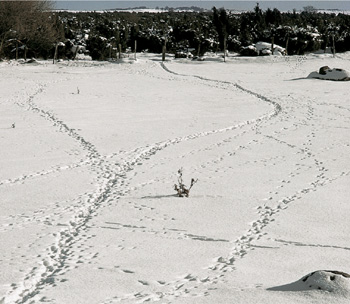
Oryctolagus cuniculus
Rabbits are smaller than hares. Males and females are the same size, each about 34–50 cm long, and the tail measures 5 cm and is black above with a distinct white underside. When the Rabbit runs, it raises its tail, and the white underside is clearly visible. The ears lack the black tip found on the ears of hares. Rabbits weigh about 1.5–2.5 kg. Compared with hares, Rabbits have more powerful front legs and shorter hind legs.
Rabbits feed exclusively on plants. They are social animals and live in colonies. They can be active both day and night, but you see them mostly in the morning and at dusk.
Rabbits have five toes on their front feet, but the innermost toe does not leave a print. The other claws leave clear marks. From their prints, Rabbits appear to have no toe pads; instead, the soles of their feet are covered with a thick, insulating, feathery layer of hair like that of hares.
Rabbits were introduced into many European countries. Biopix.

The front footprint is 3–4 cm long and about 2.5 cm wide, the hind footprint, 4–7 cm long and about 2.5 cm wide.

Like hares, Rabbits move in a hopping gait. They set their front legs down first, one directly behind the other in an almost straight line in the direction of movement. Then they rotate the hind legs forward, around and in front of the forelegs. The back legs land almost simultaneously, leaving two larger and more elongated tracks ahead of the forefeet and almost immediately one in front of the other. The length of the stride is 20–50 cm. The faster the animal moves, the greater the distance between front and hind legs. Since Rabbits have shorter hind legs than hares, they cannot jump as far, so the distance between the groups of tracks is 80 cm at most.
Rabbits dig an underground system of tunnels, usually where the ground will remain relatively dry even when it rains. You often find these tunnels in dry and light soil, especially on slopes, in embankments, on hills, and in dykes near hedges and bushes, or at woodland edges. New colonies may also be established at the edges of fields, comprising only one or a few holes.
Rabbits dig with their front feet and shove the earth away with their hind legs.
The entrance is about 10–30 cm in diameter, but occasionally can measure up to 0.5 m. From the entrance, the tunnel might stretch for several metres underground and connect to other tunnels in a network with numerous entrances. In this system of tunnels, the Rabbit can access smaller areas where it can take cover in bad weather or when in danger.
The entrance to a tunnel is often dug from the outside, and this is why you will find excavated, trampled earth in front of the hole; but the hole can also be dug from the inside, and in this case you will find no earth. In the area around the entrance holes, most of the vegetation has usually been eaten; there are also clear trails between holes that over time can become deep ruts.
Rabbit colonies are easily recognisable in both summer and winter because of their clearly marked trails.

The entrances to burrows are obvious. You will also find scat in small piles here. KR.


The female digs nest chambers, cushioned with grass and hair. When she leaves the nest, she covers the entrance with earth mixed with urine and scat. A covered entrance hole might be a sign that newborns are inside.
Rabbit trails are not as long as those used by hares, because Rabbits don’t move as far away from their colonies. The trails are often heavily trampled and grazed completely bare.
The scat is 0.7–1 cm in diameter; when compared with a hare’s, it is quite spherical. It is almost black or greenish, but bleaches with time; after about three weeks it is a uniform brown.
Rabbit tracks in fine, soft sand, with front footprint below, hind footprint above. LG.

In a colony, Rabbits use established latrines which form large mounds; however, scat is also visible in prominent places such as in clumps of grass, on tree stumps, on mole hills, and in depressions, as well as along trails and near entrances to the tunnels, often as a way to mark territory.
Rabbits have the same chisel-shaped teeth as hares, with 2 isolated teeth in the upper jaw. Gnaw marks on trees and bushes often look like the work of 4 teeth. Like hares, Rabbits can feed on the bark and branches of small trees up to a height of 60 cm, and you might also find tooth marks on turnips or large mushrooms.